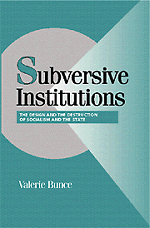Book contents
- Frontmatter
- Contents
- Preface
- 1 The Collapse of Socialism and Socialist States
- 2 Domestic Socialism: Monopoly and Deregulation
- 3 Federalism and the Soviet Bloc: Monopoly and Deregulation
- 4 Leaving Socialism
- 5 Leaving the State
- 6 Violent versus Peaceful State Dismemberment
- 7 Institutions and Opportunities: Constructing and Deconstructing Regimes and States
- Notes
- References
- Index
- Continuation of Series List
6 - Violent versus Peaceful State Dismemberment
Published online by Cambridge University Press: 05 June 2012
- Frontmatter
- Contents
- Preface
- 1 The Collapse of Socialism and Socialist States
- 2 Domestic Socialism: Monopoly and Deregulation
- 3 Federalism and the Soviet Bloc: Monopoly and Deregulation
- 4 Leaving Socialism
- 5 Leaving the State
- 6 Violent versus Peaceful State Dismemberment
- 7 Institutions and Opportunities: Constructing and Deconstructing Regimes and States
- Notes
- References
- Index
- Continuation of Series List
Summary
Culture is often not what people share, but what they choose to fight over.
Eugene Weber (quoted in Suny and Eley, 1996: 9)The past several decades in Yugoslavia may not have been a fully enjoyable present, but they have become a respectable and even enviable past.
Tibor Varady (1997: 18)In the preceding chapter, the primary task was explaining why the Yugoslav, Soviet, and Czechoslovak states ended, whereas other states in the region, so similar in history and circumstances, managed to survive. Toward that end, I focused on what these three states had in common – and what differentiated them, in turn, from their socialist neighbors. This comparison produced a relatively straightforward argument. National federalism produced over time a “dis-integration” of the Soviet, Yugoslav, and Czechoslovak states along republican lines. With the expanded opportunities for major change in the 1980s, “dis-integration” in all three instances translated quickly into actual disintegration, and the state and the regime departed from Europe in virtual tandem.
The task in this chapter is quite different, though the methodology remains the same. Of interest here is explaining variations, not similarities, in the process of state dismemberment, with a focus on the most glaring contrast among our three cases: the violent end of Yugoslavia versus the peaceful dissolution of Czechoslovakia and the Soviet Union. Our central concern now, therefore, is identifying those factors that would appear to influence whether states end amicably or violently. And a key test of the power of that explanation is whether it manages to pair the Soviet Union and Czechoslovakia against Yugoslavia.
- Type
- Chapter
- Information
- Subversive InstitutionsThe Design and the Destruction of Socialism and the State, pp. 102 - 126Publisher: Cambridge University PressPrint publication year: 1999



